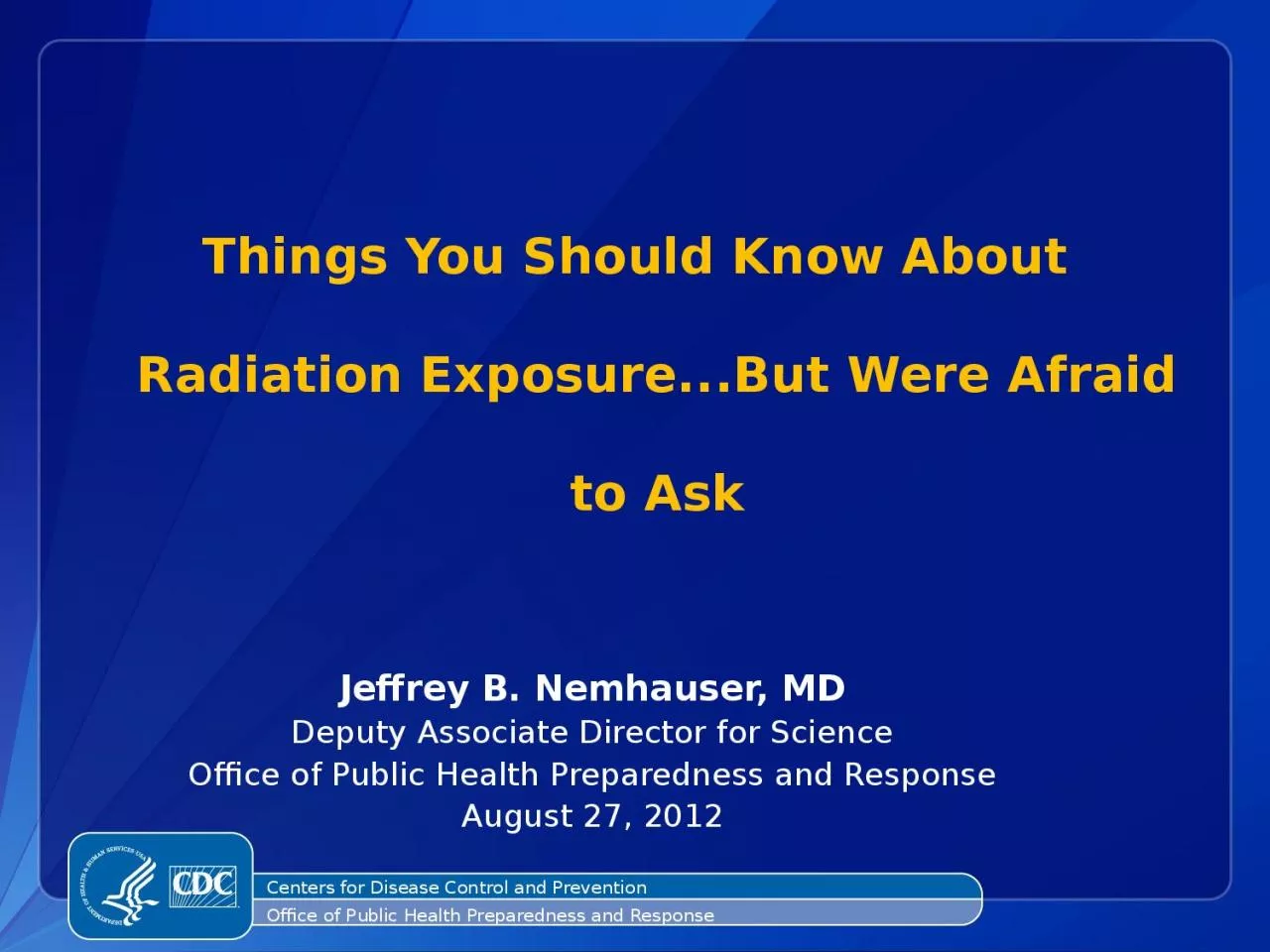

Centers for Disease Control and Prevention Office of Public Health Preparedness and Response Jeffrey B Nemhauser MD Deputy Associate Director for Science Office of Public Health Preparedness and Response ID: 916581
Download Presentation The PPT/PDF document "Things You Should Know About Radiation E..." is the property of its rightful owner. Permission is granted to download and print the materials on this web site for personal, non-commercial use only, and to display it on your personal computer provided you do not modify the materials and that you retain all copyright notices contained in the materials. By downloading content from our website, you accept the terms of this agreement.
Slide1
Things You Should Know About Radiation Exposure...But Were Afraid to Ask
Centers for Disease Control and Prevention
Office of Public Health Preparedness and Response
Jeffrey B. Nemhauser, MD
Deputy Associate Director for Science
Office of Public Health Preparedness and Response
August 27, 2012
Slide2Use of trade names or commercial sources is for informational purposes only and does not constitute an endorsement by the
United States Department of Health and Human Services or the US Public Health Service.
Views and opinions expressed by Dr.
Nemhauser
are not necessarily those of the Centers for Disease Control and Prevention
.
Slide3Radiation is a Toxicant…Sort of
RADIATION
TOXINS & TOXICANTS
Have to be ingested/inhaled to exert an effect
Have a volume of distribution
Are metabolized or undergo detoxification
Excretion can be facilitated
Uptake can be blocked
Metabolism may depend on genetic polymorphisms
Photons pass directly through the body; particles must be ingested/inhaled
No volume of distribution
Not metabolized by biological processes
Cannot be excreted
Time/distance/shielding are the means of limiting radiation exposure
Slide4Radiation is a Toxicant…Sort of
RADIATION
TOXINS & TOXICANTS
“The dose makes the poison…”
Slide5Where Physics and Biology Collide* Citations, references, and credits – Myriad Pro, 11pt
Relative Biological Effectiveness (RBE)
The effect of radiation on a test system as compared to a fixed dose of x-raysIs a function ofRadiation quality
: radiation type (electromagnetic or particle) and its energyRadiation doseNumber of dose fractionsDose rateBiological system or endpoint
Slide6Where Physics and Biology Collide* Citations, references, and credits – Myriad Pro, 11pt
Linear Energy Transfer (LET)
Energy transferred per unit length of the distance traveled by a charged particle (e.g., alpha or beta)Simple way of indicating the quality of different types of ionizing radiation (sparsely ionizing – low LET vs. densely ionizing – high LET)
The higher the energy, the lower the LET
Slide7Where Physics and Biology Collide
LET
RBE
x
-ray
100
keV
/
μ
m
200
keV
/
μ
m
Equally as effective per track, but less effective per unit dose (i.e., energy is “wasted”)
* Hall,
Giaccia
: Radiobiology for the Radiologist, 2006.
Slide8Where Physics and Biology CollideAbsorbed dose
Energy actually deposited from any kind of radiation in any kind of material as the radiation passes through it
rad = 100 ergs per gram of tissueSI Unit:
gray (Gy)1 joule per kilogram of tissue
1 Gy = 100 rad
Louis Harold Gray
“Father of Radiobiology”
Slide9Where Physics and Biology Collide
Dose equivalentAllows for different biological effectiveness of different kinds of radiation
rem is used when absorbed dose calculated in rad
SI unit: sievert (Sv) used when absorbed dose calculated in Gy
1 Sv = 100 rem
Rolf Sievert
Slide10Where Physics and Biology Collide
rad: radiation a
bsorbed doseAmount of energy absorbed by a given mass of tissue (ergs/gram)
rem: roentgen equivalent in
manTakes into account the biological effect of various types of radiation
Slide11Where Physics and Biology Collide
rem = rad x RBE*Relative Biological Effectiveness
RBE ≈ 1.0 for
β, γ, and x-radiation
RBE ≈ 2.0 for neutronsRBE ≈ 20 for alpha particles
Slide12The Law of Bergonié and Tribondeau (1906)
Actively proliferating cells are the most sensitive to the effects of radiationThe degree of differentiation of cells is inversely related to their
radiosensitivityRadiosensitivity of cells is proportional to the duration of mitotic and developmental activity they must pass through
Slide13Cellular RadiosensitivityMost
LymphocytesImmature hematopoietic cellsIntestinal epithelium
Spermatogonia & o
varian follicular cellsLeastMature red cellsMuscle cells
Mature connective tissue, bone, cartilageGanglion cells
Slide14Acute Radiation Syndrome (ARS)Radiation dose must be high
Radiation must be penetrating (i.e., able to reach internal organs)
Radiation must be delivered over a short period of time (usually minutes)Exposure area: whole body or significant partial body
Most dire acute outcome of whole body, high dose, radiation exposure
Slide15The Four Stages of ARSProdrome
Begins after exposure
Lasts 24–48 hoursMore
rapid symptom onset implies greater absorbed doseOnset of prodromal adverse health effects occurs more rapidly with more severe ARS than with more mild ARS
Latency Period (quiescent phase)Variable length depending on absorbed doseManifest Illness
Recovery or Death
Slide16ARS Prodrome – Signs and Symptoms
Nausea/vomiting
Hallmark finding but not always present
Time to vomiting may be used as rough estimate of exposure and ultimate outcome
Fever
Fatigue
Headache
Salivary gland inflammation (
hyperamylasemia
)
Diarrhea (indicator of poor prognosis)
Skin erythema
Slide17ARS Prodrome – Signs and Symptoms* Nicholas
Dainiak, Course: Response to and Management of a Radiological Crisis, Figure 2, New York School of Medicine Courses Online
. (Site registration required.)
Slide18ARS Prodrome – Early Markers*
Adapted from lecture by Col. William Dickerson, AFRRI.
Slide19ARS Prodrome – Early Markers
Absolute Lymphocyte Count
Lymphocytes
Highly radiosensitive
Progressive decline in absolute lymphocyte count provides early estimate of injury and outcome
Slide20The Three Subsyndromes of ARS* Dr. William Dickerson, (AFRRI) based on Figure 6 from
Vorobiev AI. Acute Radiation Disease and Biologic
Dosimetry in 1993. Stem Cells 1997;15(Suppl 2):269-274
Hematopoietic (Bone Marrow): 250-500 rad/2.5-5 Gy
Slide21The Three Subsyndromes of ARS* Hill G R et al. Blood 1997;90:3204-3213
GI: 1000 rad/10
Gy
Slide22The Subsyndromes of ARSNeurovascular: 10,000 rad/100
GyDeath within 24-48 hours
Exact and immediate cause of death unknownEndothelial destruction resulting in profound capillary leak
Slide23Treatment of ARS* Citations, references, and credits – Myriad Pro, 11pt
Largely limited to BM subsyndrome
Supportive CareColony Stimulating Factors (Neupogen®/filgrastim
)Antibiotics/antifungalsReverse isolationBone Marrow Transplant
Slide24http://remm.nlm.gov
Slide25